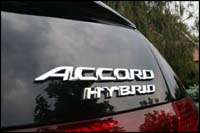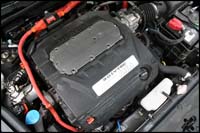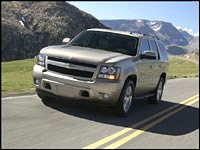So how does it work? Well, that depends on the carmaker in question. All have
 |
| Honda calls its cylinder deactivation system Variable Cylinder Management. (Photo: Justin Couture, Canadian Auto Press) |
taken advantage of new mechanical and electronic developments, such as high-speed electronic controls, sophisticated algorithm controlling systems, and the integration of electronic throttle control, but while Chrysler and GM use solenoids to activate specially designed lifters which prevent the valves from opening, Honda makes use of its sophisticated i-VTEC variable valve control system to stop the valves from opening. Either way, the end result is that a varying number of cylinders deactivate in a staggered formation, to allow for continued smooth operation, reducing the amount of fuel being burned and therefore cutting costs and simultaneously improving air quality.
Smooth operation in mind, GM and Chrysler had an easier time reducing their
 |
| Honda's 3.5L V6 was more difficult to make smooth than the domestic automakers' V8 engines. (Photo: Justin Couture, Canadian Auto Press) |
eight cylinder powerplants to four than Honda had dropping power from six cylinders to three. Even numbers make for better balance, the lack of which forced Honda to incorporate uniquely designed motor mounts to absorb vibration, as well as an innovative noise cancellation system integrated within its audio system to eliminate droning and pulsating exhaust noise, which would have otherwise ruined the upscale experience the Japanese automaker was proposing for its flagship hybrid model.
Incidentally, the time needed to switch from full-activation to a deactivated mode varies from manufacturer to manufacturer, but only by milliseconds.
 |
| Chrysler Group, which makes Chrysler branded cars, Dodge and Jeep, sells the most cylinder deactivated engines. (Photo: Trevor Hofmann, Canadian Auto Press) |
None of the transition periods are readily noticeable, which is what matters; many thanks to electronic throttle control which smoothes out the changeover so that it's virtually seamless. Also the "dead" cylinders don't drag energy from the working four, due to air being pumped through those cylinders that are temporarily out of action.
Concerns regarding variable engine wear have been voiced by opponents, but according to the three manufacturers of cylinder deactivation systems, long-term tests have shown no noticeable difference in cylinder wear patterns. Probably one of the reasons for
 |
| Amongst the latest vehicles to get cylinder deactivation is GM's new 2007 Tahoe SUV. (General Motors of Canada) |
this is that cylinders are only deactivated during light load conditions; when stress to the rings, pistons and cylinder walls is at a minimum.
While cylinder deactivation isn't the only solution needed to reduce our dependence on foreign oil and simultaneously lessen harmful emissions, it is one logical step in the right direction. Together with idle-stop systems, which shut off the engine while at idle, alternative fuels, such as ethanol, diesel and biodiesel, plus the ability to use cylinder deactivation systems in hybrids, as Honda and GM have done, and Chrysler Group soon will, its one technology that has proven both effective and reliable.

